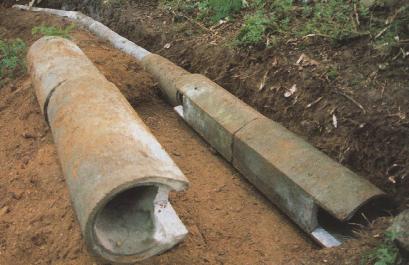
Concrete liners wait to be assembled into an artificial fox earth in Germany. This is an "in and out" design where the barking dog comes down the right section of pipe and bolts the fox into the left section of the pipe. The two sections are connected at the notches seen in the foreground. The left section then feeds back into into the main pipe stem and the fox bolts out.
In an article entitled The Rabbit and the Go to Ground Tunnel, I detailed the 20th-Century rise of artificial fox earths in the UK.
These artificial fox dens have their origin in ancient rabbit "burries" created by the Romans who introduced the rabbit to the UK about 1,000 years ago.
The artificial fox earths of the UK served as the model for the over-large "Go to Ground" tunnels we see at American Kennel Club, Jack Russell Terrier Club of America, and American Working Terrier Association trials.
Go-to-ground trials are not close approximations of field work (a caged rat is the only "quarry," and it only has to be "worked" for a minute or two) but people who do not own a deben collar or a decent shovel often think a 9" by 9" square den liner is approximately the same size as a real fox den. This misperception helps fuel a common belief held by portly matrons at dogs shows that a red fox is as big as a coyote or small wolf. As I have noted:
A large dog is almost always a liability. While a small dog can enter and work a large den, a large dog cannot enter a small earth. If a large dog is able to squeeze itself into the den pipe at all, it will find it has little room to maneuver away from the slashing jaws of the fox, raccoon or groundhog, and that it is nearly impossible to get behind the quarry in order to bolt it out of the den.
Despite this liability, some large terriers in Britain continue to find success bolting fox due to the prevalence of artificial dens or "drains" created by the mounted hunts as a way to keep fox populations stable on hunt lands. These artificial fox dens are typically 9 inches square, brick-lined, and slate-topped with two or three possible entrances.
While the construction of artificial dens or “drains” was sufficiently common at the turn of the century that Sir Jocelyn Lucas provided tips on their construction in his 1931 book, Hunt and Working Terriers, they became even more prevalent after the introduction of the myxoma virus in Great Britain in the early 1950s.
Myxomatosis was purposefully imported from South America as a way of "controlling" the U.K.’s rabbit population, which was considered a major agricultural pest. The myxoma virus was a frightfully efficient killer, wiping out 98 percent of all rabbits in Great Britain within a decade of its introduction. One result of this unhappy turn of events was that the ancient rabbit warrens that had once served as natal dens -- and sources of food -- for breeding fox simply vanished.
In order to help out Mother Nature, and improve the chance that a fox would take up residence on hunt land, many hunts constructed new artificial dens out of bricks or 9-inch drainage pipes.
At about the time that the very first artificial fox dens were being constructed in the 1920s, Kennel Club dog shows began to grow in popularity. New terrier breeds were admitted to Kennel Club rosters with some frequency, and old breeds were regularly "improved" for coat color, the set of the ear, the length of the leg, the shape and size of the head, the set of the tail, and a dozen other characteristics that barely matter in the hunt field.
The rest, as they say, is history.
It is with some interest -- and alarm -- that I note that the use of artificial dens seems to be growing in Germany. Here we find concrete and PVC pipes used in the construction of artificial fox earths. These earths are hunted about once a month in season, with the dog being entered in the pipe, and the fox easily bolted out due to the design of the artificial den.
The bolted fox is then blasted with a shotgun.
This is pretty far from genuine terrier work in my opinion, and is only a little bit better than a canned hunt. Woodcraft does not have to be very high to find a fox in this manner -- just visit the artificial dens you have previously constructed (and perhaps stocked). The dog is then entered, and the fox bolts. The dog is unlikely to face much of a fight since the fox has an easy exit. Nor does the terrier owner have to dig to the dog. These are 5 minutes affairs, not three-hour digs. As for shooting a fox with a shotgun as it exits a pipe -- could there be anything easier?
I am at a loss to understand this permutation of terrier work which is so very different from what we do in the U.S.
If we set aside the ethics of this kind of hunting and ask only what might be happening to the dogs, more alarm bells sound.
Are the Germans turning to artificial dens because their dogs are too large to work tight and twisting natural earths?
That may, in fact, be part of the impetus behind the rise of artificial earths in Germany. While the German standard for a working dachshund (teckel) calls for a dog with a small chest, the Germans insisted on creating their own brand of terrier during the strange period leading up to the rise of Nazi Germany.
I have documented the true history of the German Hunt terrier (the Jagdterrier or Jagd terrier) in previous posts and noted that this "all rounder" is too small to easily retrieve bird, and often too big to easily go to ground on fox. It is a dog that, when bred to the middle of the standard, is "betwixt and between".
You know there are problems with Jagd Terrier size when the problem becomes institutionalized in the form of a cartoon Jagd Terrier struggling to exit an artificial earth. Cartoons require an audience to "get the joke" -- to say out loud that which is widely known, even if seldom stated.
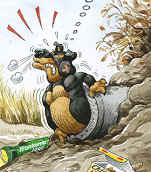
The Germans have always been an engineering and industrious people, and so it is no surprise to find they have put a lot of effort into "improving" the old "three-brick-high with a slate roof" design that characterize so many artificial earths in the UK.
Modern German earths are often made of cast concrete or even plastic pipe assembled in sections and attached to special "bedding kettles". Though there are various designs for these earths, they all feature ready exits so that a barking dog can easily bolt the fox.
Carefully designed earths mean the dog may never come face-to-face with a fox at all -- a good way to keep a dog injury-free, but also a set-up that prevents a dog from ever being in a situation where it has to demonstrate locating abilities in a complicated sette, staying power while it is being dug to over several hours, or the drive and "bottle" needed to hold a fox in a stop-end.
In fact, these German earths are designed so well that I suspect a barking Tea-cup Poodle could bolt a fox!
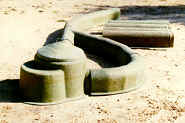
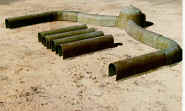
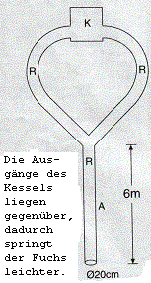

Artificial dens are simply not used in the United States. One reason for this is that our mounted hunts are not in the business of killing foxes -- once a fox goes to earth, the hounds are praised and the field rides off until another fox is found, and then the chase is on again. This is not drag hunting, but it is not vermin control either. Perhaps it is game management. A fox caught by the hounds above ground is a very rare thing, and such a stupid, slow or sick fox is best weeded from the gene pool.
Another reason we do not have artificial earths in the U.S. is that in the Eastern U.S., where red fox are most common, there are so many groundhog holes that an artificial den is unlikely to be used by a fox, no matter how well it is located.
Perhaps the most important reason we do not have artificial dens in the U.S., however, has to do with our concept of "fair chase".
"Fair chase" is a modern idea and has been framed in response to a fixed amount of wildlife and a rising tide of people and technology.
In pre-historical time you took game any way you could, but with the development of modern weapons, mankind found it could shoot out all the game and "bleed the land white" in just a few years time.
As amazing as it sounds, for example, the people of the United States killed off almost every type of large wildlife in this country between 1850 and 1900 when ethics and common sense failed to keep pace with rapid improvements in gun technology and traps.
Bison, elk, wolf, white tail deer, pronghorn, moose, turkey, eagles, beaver, and many species of ducks, geese and crane were nearly wiped off the American landscape.
In response to this devastation, the U.S. developed the concept of "fair chase". Artificial bird-calling machines were banned, as were live decoys, and the commercial sale of wild game was prohibited. Hunting of most species was limited to clear seasons and defined bag limits, and some types of hunting (such as canons loaded with shrapnel designed to kill whole flocks of geese with a single shot) were banned outright.
Today, thanks to sane wildlife laws, ethical hunters, and the finest game management professionals in the world, most forms of American wildlife can now be found in record abundance.
Other countries have set in place their own laws, regulations and customs governing "fair chase". In the UK, for example, leghold traps are considered a horror, in no small part because the British have no experience with modern off-set-jaw traps, and in part because the mounted hunts have demonized traps and poison which proved to be so efficient during Victorian times that fox were often rare and many mounted hunts were reduced to chasing stag and rabbit.
In fact, the demonization of traps, poison and guns for fox control reached such a frothy state that a legal term was coined for the crime -- Vulpicide -- which means the killing of fox by any method other than horse, hound, and terrier.
Will Germany and other countries develop their own sense of fair chase, and will it include the rejection of artificial dens or -- perversely -- their embrace?
Time will tell, but so far artificial dens seem to be gaining ground in Germany. One "sales point" for these contraptions is that they are safe for the dog, which is unlikely to tangle with the fox in any serious way. In addition, the dog can always be easily located and cave-ins are an impossibility.
It should be noted, of course, that the real reason artificial dens may be finding favor in Germany is that they are a profit center on hunting-club and farm lands in much the same way that pen-raised pheasants are a profit center at other locations.
There is clearly a demand in Germany for simple and easy "sport" among those who want to "test" their dogs and show that their dogs still have what it takes. Never mind that the test is somewhat rigged and the dogs may be a bit too big to do the job in a natural fox earth.
A red fox running free in a concrete pipe, is certainly a better test than a white rat in a welded cage at the end of a wooden tunnel! Who are we -- Americans who invented the white rat "test" -- to disagree?
Of course there are still some of us who like the other option -- the slow slogging hunt for natural dens and the back-breaking labor of digging to the dogs through marl, root and rock. This is fair chase, and it is what terrier work is really all about.
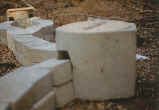
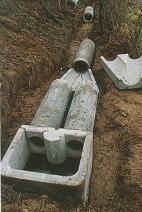
For more pictures of German artificial fox den construction, see
>> http://www.jaeger-wesermarsch.de/sonstiges/kunstbau.html
.
No comments:
Post a Comment